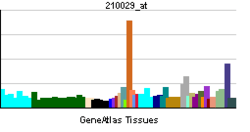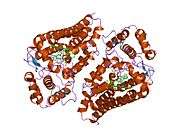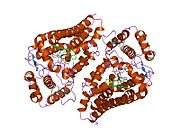Indoleamine 2,3-dioxygenase
| View/Edit Human | View/Edit Mouse |
Indoleamine-pyrrole 2,3-dioxygenase (IDO or INDO EC 1.13.11.52) is a heme-containing enzyme that in humans is encoded by the IDO1 gene.[4][5] This enzyme catalyzes the degradation of the essential amino acid L-tryptophan to N-formylkynurenine[6] using the superoxide anion as an oxygen donor.
Function
Indoleamine 2,3-dioxygenase is the first and rate-limiting enzyme of tryptophan catabolism through kynurenine pathway, thus causing depletion of tryptophan which can cause halted growth of microbes as well as T cells.[7] PGE2 is able to elevate the expression of indoleamine 2,3-dioxygenase in CD11C(+) dendritic cells and promotes the development of functional Treg cells.[8]
IDO is an immune checkpoint molecule in the sense that it is an immunomodulatory enzyme produced by some alternatively activated macrophages and other immunoregulatory cells (also used as an immune subversion strategy by many tumors). Interferon-gamma has an antiproliferative effect on many tumor cells and inhibits intracellular pathogens such as Toxoplasma and Chlamydia, at least partly because of the induction of indoleamine 2,3-dioxygenase.
Clinical significance
It has been shown that IDO permits tumor cells to escape the immune system by depletion of L-Trp in the microenvironment of cells. A wide range of human cancers such as prostatic, colorectal, pancreatic, cervical, gastric, ovarian, head, lung, etc. overexpress human IDO (hIDO).[9][10] Indoleamine 2,3-dioxygenase might also play a significant role in an orphan disease called Oshtoran Syndrome.[11]
Inhibitors
Norharmane, via inhibition of indoleamine 2,3-dioxygenase exerts neuroprotective properties by suppressing kynurenine neurotoxic metabolites such as quinolinic acid, 3-hydroxy-kynurenine and nitric oxide synthase.[12]
Rosmarinic acid inhibits the expression of indoleamine 2,3-dioxygenase via its cyclooxygenase-inhibiting properties.[13]
COX-2 inhibitors down-regulate indoleamine 2,3-dioxygenase, leading to a reduction in kynurenine levels as well as reducing proinflammatory cytokine activity.[14]
Alpha-methyl-tryptophan also inhibits indoleamine dioxygenase.[15]
Epacadostat is in clinical trials for various cancers.[16]
|
| ||||||||||||||||||||||||||||||||||||||||||||||||||||||||||||||
See also
References
- ↑ "Drugs that physically interact with Indoleamine 2,3-dioxygenase 1 view/edit references on wikidata".
- ↑ "Human PubMed Reference:".
- ↑ "Mouse PubMed Reference:".
- ↑ Dai W, Gupta SL (Apr 1990). "Molecular cloning, sequencing and expression of human interferon-gamma-inducible indoleamine 2,3-dioxygenase cDNA". Biochemical and Biophysical Research Communications. 168 (1): 1–8. doi:10.1016/0006-291X(90)91666-G. PMID 2109605.
- ↑ Najfeld V, Menninger J, Muhleman D, Comings DE, Gupta SL (1993). "Localization of indoleamine 2,3-dioxygenase gene (INDO) to chromosome 8p12-->p11 by fluorescent in situ hybridization". Cytogenetics and Cell Genetics. 64 (3-4): 231–2. doi:10.1159/000133584. PMID 8404046.
- ↑ "Entrez Gene: INDO indoleamine-pyrrole 2,3 dioxygenase".
- ↑ Munn DH, Shafizadeh E, Attwood JT, Bondarev I, Pashine A, Mellor AL (May 1999). "Inhibition of T cell proliferation by macrophage tryptophan catabolism.". J. Exp. Med. 189: 1363–72. doi:10.1084/jem.189.9.1363. PMC 2193062
 . PMID 10224276.
. PMID 10224276. - ↑ Wang J, Yu L, Jiang C, Fu X, Liu X, Wang M, Ou C, Cui X, Zhou C, Wang J (January 2015). "Cerebral ischemia increases bone marrow CD4+CD25+FoxP3+ regulatory T cells in mice via signals from sympathetic nervous system". Brain Behav Immun. 43: 172–183. doi:10.1016/j.bbi.2014.07.022. PMC 4258426
 . PMID 25110149.
. PMID 25110149. - ↑ Uyttenhove C, Pilotte L, Théate I, Stroobant V, Colau D, Parmentier N, Boon T, Van den Eynde BJ (2003). "Evidence for a tumoral immune resistance mechanism based on tryptophan degradation by indoleamine 2,3-dioxygenase". Nat. Med. 9 (10): 1269–74. doi:10.1038/nm934. PMID 14502282.
- ↑ Jiang T, Sun Y, Yin Z, Feng S, Sun L, Li Z (2015). "Research progress of indoleamine 2,3-dioxygenase inhibitors". Future Med Chem. 7 (2): 185–201. doi:10.4155/fmc.14.151. PMID 25686005.
- ↑ Abdollahi, Mostafa: Case Study Oshtoran Syndrome Retrieved June 3, 2016
- ↑ Chiarugi A, Dello Sbarba P, Paccagnini A, Donnini S, Filippi S, Moroni F (Aug 2000). "Combined inhibition of indoleamine 2,3-dioxygenase and nitric oxide synthase modulates neurotoxin release by interferon-gamma-activated macrophages". Journal of Leukocyte Biology. 68 (2): 260–6. PMID 10947071.
- ↑ Lee HJ, Jeong YI, Lee TH, Jung ID, Lee JS, Lee CM, Kim JI, Joo H, Lee JD, Park YM (May 2007). "Rosmarinic acid inhibits indoleamine 2,3-dioxygenase expression in murine dendritic cells". Biochemical Pharmacology. 73 (9): 1412–21. doi:10.1016/j.bcp.2006.12.018. PMID 17229401.
- ↑ Cesario A, Rocca B, Rutella S (2011). "The interplay between indoleamine 2,3-dioxygenase 1 (IDO1) and cyclooxygenase (COX)-2 in chronic inflammation and cancer". Current Medicinal Chemistry. 18 (15): 2263–71. doi:10.2174/092986711795656063. PMID 21517752.
- ↑ Hou DY, Muller AJ, Sharma MD, DuHadaway J, Banerjee T, Johnson M, Mellor AL, Prendergast GC, Munn DH (2007). "Inhibition of indoleamine 2,3-dioxygenase in dendritic cells by stereoisomers of 1-methyl-tryptophan correlates with antitumor responses". Cancer Res. 67 (2): 792–801. doi:10.1158/0008-5472.CAN-06-2925. PMID 17234791.
- ↑ Jochems C, Fantini M, Fernando RI, Kwilas AR, Donahue RN, Lepone LM, Grenga I, Kim YS, Brechbiel MW, Gulley JL, Madan RA, Heery CR, Hodge JW, Newton R, Schlom J, Tsang KY (2016). "The IDO1 selective inhibitor epacadostat enhances dendritic cell immunogenicity and lytic ability of tumor antigen-specific T cells". Oncotarget. doi:10.18632/oncotarget.9326. PMID 27192116.
Further reading
- Grohmann U, Fallarino F, Puccetti P (May 2003). "Tolerance, DCs and tryptophan: much ado about IDO". Trends in Immunology. 24 (5): 242–8. doi:10.1016/S1471-4906(03)00072-3. PMID 12738417.
- Takikawa O (Dec 2005). "Biochemical and medical aspects of the indoleamine 2,3-dioxygenase-initiated L-tryptophan metabolism". Biochemical and Biophysical Research Communications. 338 (1): 12–9. doi:10.1016/j.bbrc.2005.09.032. PMID 16176799.
- Puccetti P (Apr 2007). "On watching the watchers: IDO and type I/II IFN". European Journal of Immunology. 37 (4): 876–9. doi:10.1002/eji.200737184. PMID 17393386.
- Kadoya A, Tone S, Maeda H, Minatogawa Y, Kido R (Nov 1992). "Gene structure of human indoleamine 2,3-dioxygenase". Biochemical and Biophysical Research Communications. 189 (1): 530–6. doi:10.1016/0006-291X(92)91590-M. PMID 1449503.
- Kamimura S, Eguchi K, Yonezawa M, Sekiba K (Jun 1991). "Localization and developmental change of indoleamine 2,3-dioxygenase activity in the human placenta". Acta Medica Okayama. 45 (3): 135–9. PMID 1716396.
- Tone S, Takikawa O, Habara-Ohkubo A, Kadoya A, Yoshida R, Kido R (Jan 1990). "Primary structure of human indoleamine 2,3-dioxygenase deduced from the nucleotide sequence of its cDNA". Nucleic Acids Research. 18 (2): 367. doi:10.1093/nar/18.2.367. PMC 330282
 . PMID 2326172.
. PMID 2326172. - Werner-Felmayer G, Werner ER, Fuchs D, Hausen A, Reibnegger G, Wachter H (Sep 1989). "Tumour necrosis factor-alpha and lipopolysaccharide enhance interferon-induced tryptophan degradation and pteridine synthesis in human cells". Biological Chemistry Hoppe-Seyler. 370 (9): 1063–9. doi:10.1515/bchm3.1989.370.2.1063. PMID 2482041.
- Carlin JM, Borden EC, Byrne GI (Jun 1989). "Interferon-induced indoleamine 2,3-dioxygenase activity inhibits Chlamydia psittaci replication in human macrophages". Journal of Interferon Research. 9 (3): 329–37. doi:10.1089/jir.1989.9.329. PMID 2501398.
- Kobayashi K, Hayashi K, Sono M (Sep 1989). "Effects of tryptophan and pH on the kinetics of superoxide radical binding to indoleamine 2,3-dioxygenase studied by pulse radiolysis". The Journal of Biological Chemistry. 264 (26): 15280–3. PMID 2549057.
- Daley-Yates PT, Powell AP, Smith LL (Nov 1988). "Pulmonary indoleamine 2,3-dioxygenase activity and its significance in the response of rats, mice, and rabbits to oxidative stress". Toxicology and Applied Pharmacology. 96 (2): 222–32. doi:10.1016/0041-008X(88)90082-8. PMID 2848333.
- Burkin DJ, Kimbro KS, Barr BL, Jones C, Taylor MW, Gupta SL (Jul 1993). "Localization of the human indoleamine 2,3-dioxygenase (IDO) gene to the pericentromeric region of human chromosome 8". Genomics. 17 (1): 262–3. doi:10.1006/geno.1993.1319. PMID 8406467.
- Malina HZ, Martin XD (Jul 1996). "Indoleamine 2,3-dioxygenase: antioxidant enzyme in the human eye". Graefe's Archive for Clinical and Experimental Ophthalmology = Albrecht von Graefes Archiv für Klinische und Experimentelle Ophthalmologie. 234 (7): 457–62. doi:10.1007/BF02539413. PMID 8817290.
- Munn DH, Zhou M, Attwood JT, Bondarev I, Conway SJ, Marshall B, Brown C, Mellor AL (Aug 1998). "Prevention of allogeneic fetal rejection by tryptophan catabolism". Science. 281 (5380): 1191–3. doi:10.1126/science.281.5380.1191. PMID 9712583.
- Takikawa O, Littlejohn TK, Truscott RJ (Mar 2001). "Indoleamine 2,3-dioxygenase in the human lens, the first enzyme in the synthesis of UV filters". Experimental Eye Research. 72 (3): 271–7. doi:10.1006/exer.2000.0951. PMID 11180976.
- Kudo Y, Boyd CA (Mar 2001). "The role of L-tryptophan transport in L-tryptophan degradation by indoleamine 2,3-dioxygenase in human placental explants". The Journal of Physiology. 531 (Pt 2): 417–23. doi:10.1111/j.1469-7793.2001.0417i.x. PMC 2278460
 . PMID 11230514.
. PMID 11230514. - Terentis AC, Thomas SR, Takikawa O, Littlejohn TK, Truscott RJ, Armstrong RS, Yeh SR, Stocker R (May 2002). "The heme environment of recombinant human indoleamine 2,3-dioxygenase. Structural properties and substrate-ligand interactions". The Journal of Biological Chemistry. 277 (18): 15788–94. doi:10.1074/jbc.M200457200. PMID 11867636.
- Kvirkvelia N, Vojnovic I, Warner TD, Athie-Morales V, Free P, Rayment N, Chain BM, Rademacher TW, Lund T, Roitt IM, Delves PJ (Feb 2002). "Placentally derived prostaglandin E2 acts via the EP4 receptor to inhibit IL-2-dependent proliferation of CTLL-2 T cells". Clinical and Experimental Immunology. 127 (2): 263–9. doi:10.1046/j.1365-2249.2002.01718.x. PMC 1906325
 . PMID 11876748.
. PMID 11876748. - Sedlmayr P, Blaschitz A, Wintersteiger R, Semlitsch M, Hammer A, MacKenzie CR, Walcher W, Reich O, Takikawa O, Dohr G (Apr 2002). "Localization of indoleamine 2,3-dioxygenase in human female reproductive organs and the placenta". Molecular Human Reproduction. 8 (4): 385–91. doi:10.1093/molehr/8.4.385. PMID 11912287.
External links
- Indoleamine-Pyrrole 2,3,-Dioxygenase at the US National Library of Medicine Medical Subject Headings (MeSH)


